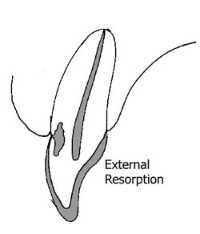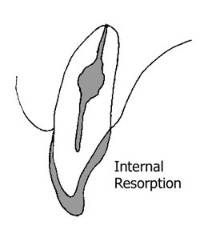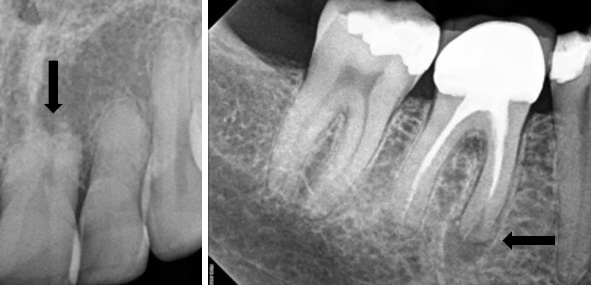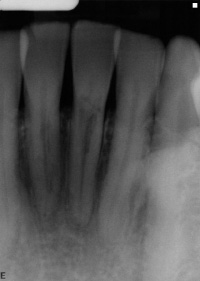Resorption
If your dentist referred you to Dr. Potter because he or she said you have “resorption,” you probably thought, “I have WHAT?”
Tooth resorption is a process by which tooth structure starts to be removed by our own cells that normally remove bone (osteoclasts). This process is normal in bone because there are also cells that rebuild bone throughout our whole lives (osteoblasts). However, teeth lack these reciprocating cells and therefore tooth resorption is considered a disease process and can become very problematic. While the exact cause of resorption is unknown, it is usually associated with trauma, infection, bleaching, and even certain types of orthodontics.


There are many different types of tooth resorption. Internal resorption is initiated on the inside of the tooth at the pulp. External resorption is initiated on the exterior surface of the root. There are many different types of external resorption. Inflammatory root resorption is usually from a diseased pulp and is often found at the apex or tip of the root.
Apical resorption is a type of external root resorption that is found at the tip of the root when there are bacteria present in the root area.

Invasive cervical resorption is found where the crown of the tooth and the root meet. This type of resorption is perhaps the most curious, as it is becoming more and more common and we really don’t know what causes it.
If your dentist has referred you to Dr. Potter because they fear you have invasive cervical resorption, you may or may not have symptoms. This process sometimes creates inflammation in the nerve space which can cause a tooth ache or cold sensitivity, but it does not always cause this type of inflammation. Many times this process is found on routine radiographic exam. There are many treatment options for this type of resorption, and the option that is best for you depends on the location, size, and depth of the lesion.

Dr. Potter will likely want a 3D CBCT scan of the tooth in order to clearly see the location, size, and depth so that you can come up with an individualized treatment plan that suits you best.
Many teeth with invasive cervical resorption can be saved with endodontic treatment. However, the process of resorption is a progressive disease, so we can sometimes see recurrence down the road. This does compromise the long-term prognosis of doing a root canal on a tooth like this. Occasionally, a small surgical procedure of the gum is needed in addition to endodontic treatment to give the tooth the best chances of long-term success. If the resorption is too extensive, the best treatment option may be extraction. Other times, the best course of action is no treatment. Have your tooth evaluated as soon as your dentist identifies resorption so that Dr. Potter can advise you on which course of action may be best for you.
Location & Contact
665 Camino de los Mares, Suite 204
San Clemente, CA 92673
Map & Directions
Phone: (949) 661-9680
Fax: (949) 661-4872
Email: Contact Us
Office Hours
Mon – Fri: 8am – 5pm






